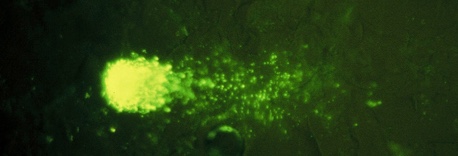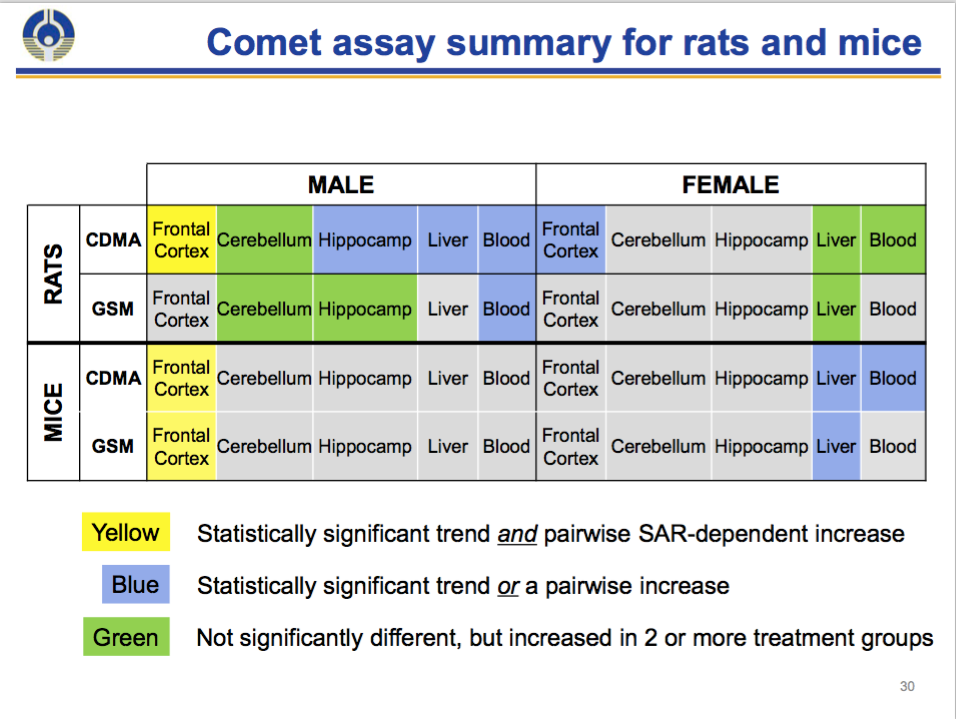NTP: Cell Phone RF Breaks DNA
Consistent with Higher Tumor Counts
20 Years After Landmark Lai-Singh Study
In May, the U.S. National Toxicology Program (NTP) announced that male rats exposed to cell phone radiation developed higher rates of cancer. Soon, the NTP will explain how that might have happened.
The same RF/microwave radiation that led male rats to develop brain tumors also caused DNA breaks in their brains. Female rats —which did not have significant elevated tumor counts— had fewer DNA breaks.
All these findings are part of the same $25 million NTP project.
The NTP results provide “strong evidence for the genotoxicity of cell phone radiation,” Ron Melnick told Microwave News. Melnick led the team that designed the NTP study; he is now retired. This “should put to rest the old argument that RF radiation cannot cause DNA damage,” he said.
DNA breaks were also seen in the brains of the RF-exposed mice, though the increases were less pronounced than among the rats. The NTP has not yet released the tumor results for its study in mice.
The NTP project design called for a sample of rats to be sacrificed after 19 weeks of post-natal radiation exposure —five from each of the GSM and CDMA exposure groups, as well as five of the controls.1 Tissue samples for DNA assays were collected from those animals.2 The remainder of the rats continued to be exposed for the rest of the two-year cancer study.
A paper on the DNA findings has been submitted for publication and is currently under peer review, according to the NTP press office.3 Michael Wyde, who runs the NTP RF project day-to-day, presented some preliminary results at the BioEM2016 meeting in Ghent, Belgium, in June and later that month at the NTP Board of Counselors meeting. (His slides4 are here; and a video of his talk at the board meeting is here.5)
Are DNA Breaks Harbingers of Tumors?
The new results prompt this $64 question: Did the DNA breaks found at the interim kill cause or lead to the tumors that were seen at the end of the experiment?
“You can’t say that the DNA assay supports the finding of increased glioma,” said one NTP insider who asked not to be named. But then this person went on to add, “You can say they are consistent.”
Melnick, who spent close to 30 years at NTP before retiring in 2009, offered a more direct answer: “Finding DNA damage in the brain of rats supports NTP’s tumor data,” he said.
We posed the same question to John Bucher, the associate director of the NTP who is in charge of the cell phone study. He declined to respond. Nor would he say whether the apparent consistency of the DNA and tumor results played a role in his decision to expedite the release of the tumor findings in May before they were published in a journal.
20 Years of War Games
The NTP’s finding of DNA breaks is the latest, and perhaps most decisive, chapter in a controversy that goes back more than 20 years. In 1994, Henry Lai and N.P. Singh of the University of Washington in Seattle reported that RF radiation could damage DNA in the brain cells of rats. (They used pulsed 2450 MHz, not cell phone-like signals.) The Lai-Singh study was immediately challenged by the wireless companies as it threatened their central argument that cell phones cannot cause cancer.
Motorola led the charge. Q. Balzano, a senior Motorola executive, told us at the time that, even if the Lai-Singh experiment were to be validated, “the effects it purports to show may be inconsequential” (see MWN, N/D94, p.1). Balzano, an engineer by training, chose to sidestep the well-established principle that DNA damage can lead to cancer development and growth.
At the same time, PR operatives working for Motorola were developing a campaign to discredit the Lai-Singh work. The now-infamous “war gaming memo” was part of that effort (see MWN, J/F97, p.13).
Motorola went on to sponsor studies in Joseph Roti Roti’s lab at Washington University in St. Louis. Roti Roti did not find DNA breaks (see “Two Labs at Odds over Microwaves and DNA Breaks.”) As far as Motorola was concerned, Lai-Singh had been proved wrong and the matter was settled.
Nevertheless, the research continued.
A decade later, a similar dispute arose when a team at the University of Vienna, working under the EC-sponsored REFLEX project, reported seeing RF-induced DNA breaks. Those experiments were carried out in vitro, that is, in cell cultures (see MWN, M/A03, p.7). This clash was just as nasty —perhaps more so— and led to formal accusations of fraud and scientific misconduct. None of the charges stuck, but they left a taint on the whole enterprise. (Read about Science magazine’s coverage.)
Today, no one talks much about DNA breaks anymore. Lai, who has retired from UW but still serves as the co-editor-in-chief of Electromagnetic Biology and Medicine (EBM) continues to keep close tabs on what others have been publishing. “There have been 73 studies on DNA breaks since our initial report,” he told us in a recent interview, “A clear majority has found an effect similar to ours.”6
The Comet Assay
All 73 studies on Lai’s list measured DNA damage using what’s known as the comet assay.7 The assay was developed by Singh, Lai’s collaborator, close to 30 years ago.8 It can detect single- and double-strand DNA breaks, as well as other potentially genotoxic changes. The assay gets its name from the comet-like tail formed by fragments of the broken DNA. The more DNA damage, the longer and more diffuse the tail (see an example below, image by N.P. Singh, provided by Henry Lai).

The comet assay is one of the standard techniques for evaluating genetic hazards —sometimes with DNA taken from animals (in vivo) and sometimes from cell cultures (in vitro). The assay is used routinely by the NTP for testing chemicals. The OECD, for instance, has called the comet assay carried out in vivo “especially relevant” for evaluating potential cancer agents. Both the original Lai-Singh and the new NTP studies used RF–exposed rats.
“An in vivo comet assay is usually more informative than an in vitro comet assay,” said Raymond Tice. Back in the 1980’s, Tice helped Singh develop the comet assay. He joined the NTP in 2005, becoming the chief of its Biomolecular Screening Branch before retiring last year. He currently serves as an advisor to the NTP.
Of the 73 RF–comet assay papers that Lai has catalogued, there are 28 studies that used in vivo exposures. “Those showing DNA breaks outnumber those that don’t by more than three to one,” he told us (22 vs. 6).9
“I have no doubt that low-intensity RF radiation is toxic to DNA,” Lai said.
NTP’s Genotoxicity Results
Before the NTP study got underway, Melnick’s team targeted a number of the rats’ body parts, including three regions of the brain, to be tested for DNA breaks. One of these was the frontal cortex of the brain, because, as Christine Flowers, NTP’s Director of Communications, told us, it is “an area in which tumors were reported in humans.”
Indeed, according to Melnick, the finding of brain cancer among cell phone users, as well as the original Lai-Singh DNA experiment, prompted him to include the DNA analysis as part of the NTP protocol. (Cell phone epidemiological studies led IARC to classify RF radiation as a possible human carcinogen in 2011.)
As it turned out, the frontal cortex is where the NTP saw the most significant increases in DNA breaks. (See the color-coded slide below, taken from Wyde’s presentation at the BioEM2016 meeting in June.)
The NTP later found brain tumors —gliomas— among those rats exposed for the full two years. The NTP has not specified the specific locations in the brain where the gliomas were seen. The DNA assayed in the brain was from a mix of various types, including glial cells, the kind that later turned cancerous.
Wyde has pointed that there were responders and non-responders among the male rats that were exposed to radiation.10 Only some of the animals showed DNA effects but these were large enough to move the averages up to indicate significant differences.
No DNA analysis was done for rat tissues with Schwann cells in the heart, the other site where tumors were seen after two years of exposure.11 The Schwannomas were unexpected, and only uncovered long after the samples had been collected following the interim kill.

Slide No.30 from NTP’s Michael Wyde presentation at the BioEM2016 meeting in June in Ghent, Belgium
October 22, 2019
The NTP paper on DNA breaks has been published in Environmental and Molecular Mutagenesis. The abstract is here.
__________________________________
1. The exposures lasted 18 hours a day (power on for 10 minutes and off for 10 minutes), seven days a week. The total RF exposure time was 9 hours a day. Three different exposure levels were used: SARs of 1.5, 3 and 6 W/Kg. Details of the experiment are here.
2. The exposure of the rats began while they were still in the womb. The protocol for the mice was similar except that those exposures began at the age of six weeks. After 13 weeks or exposure, 15 mice were sacrificed and their DNA analyzed.
3. Stephanie Smith-Roe et al., “Evaluation of the Genotoxicity of Cell Phone Radiofrequency Radiation Male and Female Rats and Mice Following Subchronic Exposure,” in press.
4. See also Wyde’s PowerPoint presentation at the GLORE meeting in November 2013. GLORE stands for Global Coordination of Research and Health Policy on RF Electromagnetic Fields.
5. Wyde’s discussion of the genotoxicity results begins at the 31:51-minute mark of the video.
6. Of the 73 studies on Lai’s list, 46 (63%) found an effect and 27 (37%) did not. Lai and Singh have also shown that power-frequency (ELF) EMFs can cause DNA breaks (see their 1997 paper). Here again, Lai has catalogued the papers that followed their initial report. As of now, there have been 44 studies, of which 32 (73%) found an effect and 12 (27%) did not.
7. This summer, a team from Germany published a detailed review of the comet assay. Note that the assay is just one of a number of techniques used to measure genetic effects. Lai has also catalogued this larger RF-genotoxicity literature. At last count, in 2014, there was a total of 125 papers, of which 84 (66%) showed effects and 41 (34%) did not.
8. Singh recently wrote up his reflections on the comet assay’s development, evolution and applications.
9. Not taken into account in Lai’s analysis is the funding source of the studies. For a discussion of industry, military and other influences on RF–DNA research, see our “Radiation Research and the Cult of Negative Studies,” written ten years ago.
10. Wyde says this in a talk to the NTP Board of Scientific Counselors in June 2016. The discussion of the genotoxicity results begins at the 31:51-minute mark of the video (also here).
11. At the same NTP Board of Scientific Counselors meeting, Linda Birnbaum, the director of NTP (& NIEHS), talked about the link between RF and the Schwannommas of the heart. In the video of the meeting, she called the association “unequivocally clear” (@43:20-minute mark) and a few minutes later described it as having a “beautiful dose-relationship.” A full set of videos from the meeting are here.
